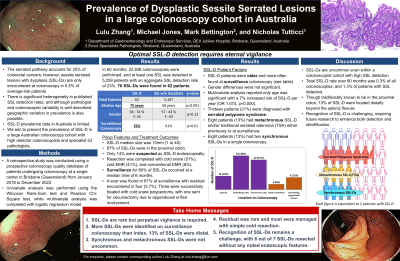Sunday Poster Session
Category: Colon
P0182 - Prevalence of Dysplastic Sessile Serrated Lesions in a Large Colonoscopy Cohort in Australia
Sunday, October 22, 2023
3:30 PM - 7:00 PM PT
Location: Exhibit Hall

Has Audio

Lulu Zhang, MBBS, BSc
QEII Jubilee Hospital
Brisbane, Queensland, Australia
Presenting Author(s)
Lulu Zhang, MBBS, BSc1, Nicholas Tutticci, MBBS, BSc1, Mark Bettington, MBBS, BSc2
1QEII Jubilee Hospital, Brisbane, Queensland, Australia; 2Envoi Specialist Pathologists, Brisbane, Queensland, Australia
Introduction: The serrated pathway accounts for 25% of colorectal cancers; however, sessile serrated lesions with dysplasia (SSL-Ds) are only encountered at colonoscopy in 0.5% of average-risk patients. There is significant heterogeneity in published SSL detection rates, and although pathologist and colonoscopist variability is well described, geographic variation in prevalence is also possible. Data on SSL-D prevalence in Australia is limited. We aim to present SSL-D prevalence in a large colonoscopy cohort with high detector colonoscopists.
Methods: A retrospective study was conducted using a prospective colonoscopy quality database of patients undergoing colonoscopy at a single center from January 2018 to December 2022. Univariate analysis (Wilcoxon Rank-Sum test and Pearson Chi-Square test) and multivariate analysis (multiple logistic regression) were performed.
Results: In 5 years, 21,903 colonoscopies were completed with 5,261 SSLs detected (24% detection rate). 70 SSL-Ds were identified at 62 colonoscopies (1.2% of procedures with SSL identified). SSL-D patients were older (median age 75 vs 58 years, p< 0.001) with a trend towards female association (67% vs 57%, p=0.09). SSL-Ds were more often found at surveillance colonoscopy than index (77% vs 23%). On multivariate analysis, only older age was an independent predictor of SSL-D (odds ratio 1.07, 95% confidence interval 1.05-1.1).
SSL-Ds were mainly found in the proximal colon (89%), with a mean size of 12mm (range 1 to 40mm) and were treated with cold snare (50%) or cold EMR (41%). 80% of SSL-Ds had surveillance at a median interval of 6 months. SSL-D residuals were encountered in only 4 (5.7% of total SSL-D). These returned bland on histology and cured with repeat cold snare resection, though one required cecumectomy due to location. Serrated polyposis syndrome was diagnosed in 21.4% of SSL-D patients.
Discussion: We present one of Australia’s largest colonoscopy-based SSL-D cohorts. SSL-Ds were more common on surveillance, which is a reminder to colonoscopists to remain vigilant, although multivariant analysis suggests that this may be a surrogate marker for increasing age. Majority of SSL-Ds were successfully managed endoscopically with residual dysplasia detected in a minority of cases which were cured with repeat cold snare resection. A sole SSL-D residual was confirmed at the appendiceal orifice polyp which ultimately proceeded to cecumectomy. Overall, SSL-Ds are relatively uncommon even within a high SSL prevalence cohort in Australia.
Disclosures:
Lulu Zhang, MBBS, BSc1, Nicholas Tutticci, MBBS, BSc1, Mark Bettington, MBBS, BSc2. P0182 - Prevalence of Dysplastic Sessile Serrated Lesions in a Large Colonoscopy Cohort in Australia, ACG 2023 Annual Scientific Meeting Abstracts. Vancouver, BC, Canada: American College of Gastroenterology.
1QEII Jubilee Hospital, Brisbane, Queensland, Australia; 2Envoi Specialist Pathologists, Brisbane, Queensland, Australia
Introduction: The serrated pathway accounts for 25% of colorectal cancers; however, sessile serrated lesions with dysplasia (SSL-Ds) are only encountered at colonoscopy in 0.5% of average-risk patients. There is significant heterogeneity in published SSL detection rates, and although pathologist and colonoscopist variability is well described, geographic variation in prevalence is also possible. Data on SSL-D prevalence in Australia is limited. We aim to present SSL-D prevalence in a large colonoscopy cohort with high detector colonoscopists.
Methods: A retrospective study was conducted using a prospective colonoscopy quality database of patients undergoing colonoscopy at a single center from January 2018 to December 2022. Univariate analysis (Wilcoxon Rank-Sum test and Pearson Chi-Square test) and multivariate analysis (multiple logistic regression) were performed.
Results: In 5 years, 21,903 colonoscopies were completed with 5,261 SSLs detected (24% detection rate). 70 SSL-Ds were identified at 62 colonoscopies (1.2% of procedures with SSL identified). SSL-D patients were older (median age 75 vs 58 years, p< 0.001) with a trend towards female association (67% vs 57%, p=0.09). SSL-Ds were more often found at surveillance colonoscopy than index (77% vs 23%). On multivariate analysis, only older age was an independent predictor of SSL-D (odds ratio 1.07, 95% confidence interval 1.05-1.1).
SSL-Ds were mainly found in the proximal colon (89%), with a mean size of 12mm (range 1 to 40mm) and were treated with cold snare (50%) or cold EMR (41%). 80% of SSL-Ds had surveillance at a median interval of 6 months. SSL-D residuals were encountered in only 4 (5.7% of total SSL-D). These returned bland on histology and cured with repeat cold snare resection, though one required cecumectomy due to location. Serrated polyposis syndrome was diagnosed in 21.4% of SSL-D patients.
Discussion: We present one of Australia’s largest colonoscopy-based SSL-D cohorts. SSL-Ds were more common on surveillance, which is a reminder to colonoscopists to remain vigilant, although multivariant analysis suggests that this may be a surrogate marker for increasing age. Majority of SSL-Ds were successfully managed endoscopically with residual dysplasia detected in a minority of cases which were cured with repeat cold snare resection. A sole SSL-D residual was confirmed at the appendiceal orifice polyp which ultimately proceeded to cecumectomy. Overall, SSL-Ds are relatively uncommon even within a high SSL prevalence cohort in Australia.
Disclosures:
Lulu Zhang indicated no relevant financial relationships.
Nicholas Tutticci indicated no relevant financial relationships.
Mark Bettington indicated no relevant financial relationships.
Lulu Zhang, MBBS, BSc1, Nicholas Tutticci, MBBS, BSc1, Mark Bettington, MBBS, BSc2. P0182 - Prevalence of Dysplastic Sessile Serrated Lesions in a Large Colonoscopy Cohort in Australia, ACG 2023 Annual Scientific Meeting Abstracts. Vancouver, BC, Canada: American College of Gastroenterology.

